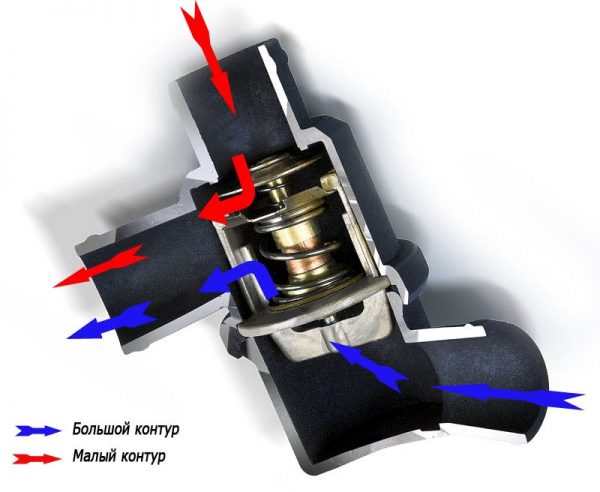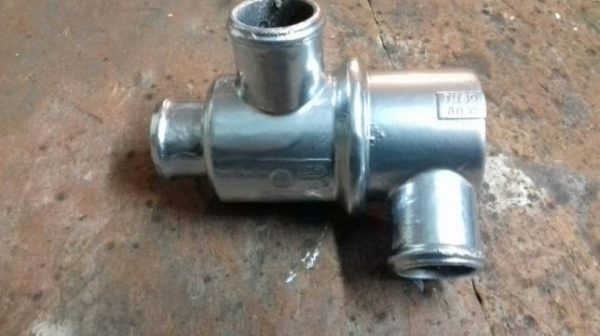
Everything you need to know about the VAZ 2101 thermostat
Content
The slightest violation of the thermal regime of an automobile engine can cause its failure. The most dangerous factor for the power plant is overheating. Most often, it occurs due to a malfunction of the thermostat - one of the main elements of the cooling system.
Thermostat VAZ 2101
"Kopecks", like other representatives of classic VAZs, were equipped with domestically produced thermostats, produced under the catalog number 2101-1306010. The same parts were installed on cars of the Niva family.

Why you need a thermostat
The thermostat is designed to maintain the optimal thermal regime of the engine. In fact, it is an automatic temperature controller that allows you to warm up a cold engine faster and cool it when heated to the limit value.
For the VAZ 2101 engine, the optimum temperature is considered to be in the range of 90–115 oC. Exceeding these values is fraught with overheating, which can cause the cylinder head gasket (cylinder head) to burn out, followed by depressurization of the cooling system. Moreover, the engine can simply jam due to the increase in the size of the pistons caused by high temperature.

Of course, this will not happen with a cold engine, but it will not be able to work stably until it warms up to the optimum temperature. All design characteristics of the power unit regarding power, compression ratio and torque directly depend on the thermal regime. In other words, a cold engine is not able to give the performance that is declared by the manufacturer.
Design
Structurally, the VAZ 2101 thermostat consists of three blocks:
- non-separable body with three nozzles. It is made of metal, which has good chemical resistance. It can be copper, brass or aluminum;
- thermoelement. This is the main part of the device, which is located in the central part of the thermostat. The thermoelement consists of a metal case made in the form of a cylinder and a piston. The inner space of the part is filled with a special technical wax, which tends to actively expand when heated. Increasing in volume, this wax pushes a spring-loaded piston, which, in turn, actuates the valve mechanism;
- valve mechanism. It includes two valves: bypass and main. The first serves to ensure that the coolant has the opportunity to circulate through the thermostat when the engine is cold, bypassing the radiator, and the second opens the way for it to go there when heated to a certain temperature.
 The bypass valve opens at low temperatures and allows the coolant to pass directly into the engine, and the main valve when heated to a certain temperature, directing the liquid along a large circuit to the radiator
The bypass valve opens at low temperatures and allows the coolant to pass directly into the engine, and the main valve when heated to a certain temperature, directing the liquid along a large circuit to the radiator
The internal structure of each block is of only theoretical interest, because the thermostat is a non-separable part that changes entirely.
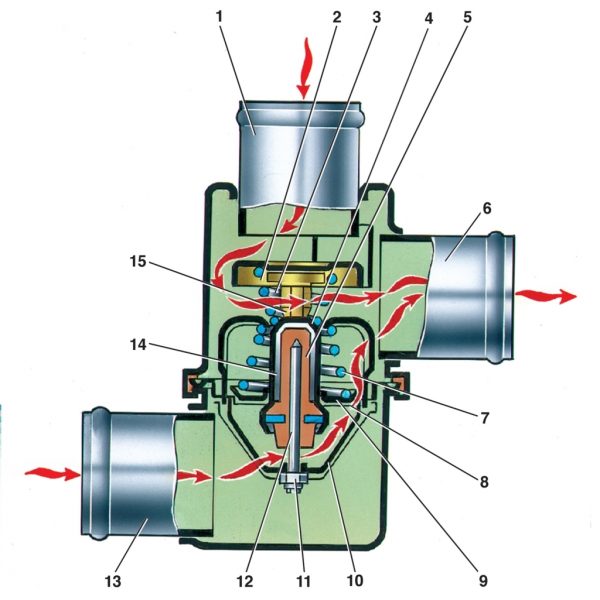
Operating principle
The cooling system of the VAZ 2101 engine is divided into two circles through which the refrigerant can circulate: small and large. When starting a cold engine, the liquid from the cooling jacket enters the thermostat, the main valve of which is closed. Passing through the bypass valve, it goes directly to the water pump (pump), and from it back to the engine. Circulating in a small circle, the liquid does not have time to cool, but only heats up. When it reaches a temperature of 80–85 oWith the wax inside the thermoelement begins to melt, increasing in volume and pushing the piston. At the first stage, the piston only slightly opens the main valve and part of the coolant enters the large circle. Through it, it moves to the radiator, where it cools down, passing through the tubes of the heat exchanger, and already cooled down, it is sent back to the engine cooling jacket.

The main part of the liquid continues to circulate in a small circle, but when its temperature reaches 93–95 oC, the thermocouple piston extends as far as possible from the body, fully opening the main valve. In this position, all the refrigerant moves in a large circle through the cooling radiator.
Video: how the thermostat works
Which thermostat is better
There are only two parameters by which a car thermostat is usually chosen: the temperature at which the main valve opens and the quality of the part itself. Regarding the temperature, the opinions of car owners differ. Some want it to be higher, i.e., the engine warms up less time, while others, on the contrary, prefer to warm up the engine longer. The climatic factor should be taken into account here. When operating the car in normal temperature conditions, a standard thermostat that opens at 80 oC. If we are talking about cold regions, then it is better to choose a model with a higher opening temperature.
As for the manufacturers and quality of thermostats, according to the reviews of the owners of "kopecks" and other classic VAZs, parts made in Poland (KRONER, WEEN, METAL-INKA), as well as in Russia with Polish thermoelements ("Pramo") are the most popular. It is not worth considering temperature controllers made in China as a cheap alternative.
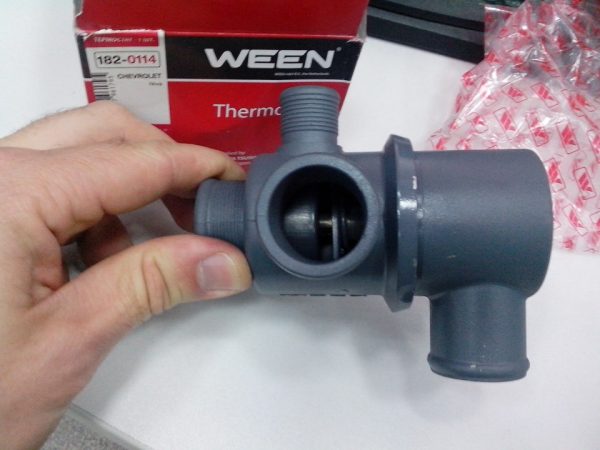

Where is the thermostat
In the VAZ 2101, the thermostat is located in front of the engine compartment on the right side. You can easily find it by the thick cooling system hoses that fit it.
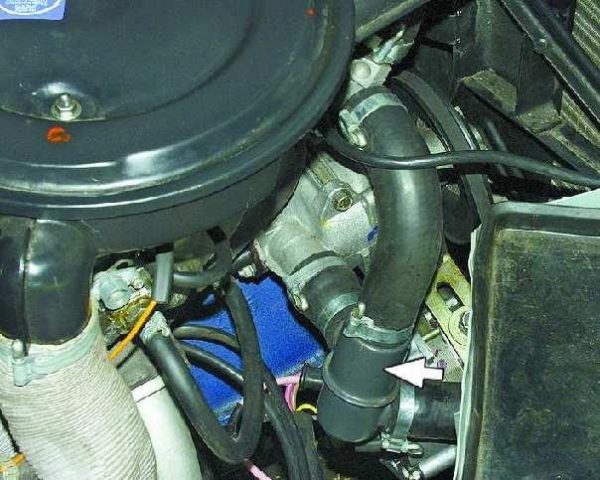

Malfunctions of the VAZ 2101 thermostat and their symptoms
The thermostat can have only two breakdowns: mechanical damage, due to which the device body has lost its tightness, and jamming of the main valve. It makes no sense to consider the first malfunction, since it happens extremely rarely (as a result of an accident, inept repair, etc.). In addition, such a breakdown can be determined even by visual inspection.
The jamming of the main valve happens much more often. Moreover, it can jam both in the open and in the closed or middle position. In each of these cases, the signs of its failure will be different:
- the engine takes a long time to warm up. According to the passport data of the VAZ 2101, the power plant should warm up to operating temperature in 4–7 minutes, depending on the ambient temperature. If the motor does not fit within this time, most likely, the main valve is stuck in the open position. In this case, from the moment the engine starts, the coolant passes in a large circle, i.e. through the radiator, where its temperature decreases. To confirm or refute your suspicions, you need to start a cold engine, wait 1-2 minutes and touch the rubber hose connecting the thermostat and the upper radiator tank with your hand. If it is warm, the valve is definitely stuck in the open or middle position. It is possible to continue operating the car in such cases, but there is no guarantee that the valve will not move in the opposite direction and will not “stick”, blocking the flow of refrigerant to the radiator;

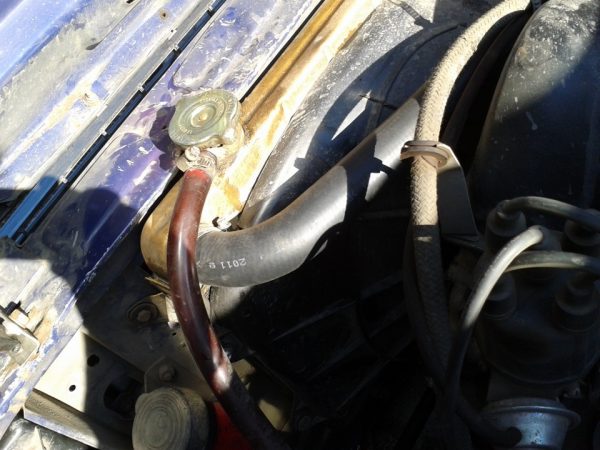 If the upper radiator hose becomes warm after 1-2 minutes of engine operation, then the main thermostat valve is stuck open
If the upper radiator hose becomes warm after 1-2 minutes of engine operation, then the main thermostat valve is stuck open - the engine warms up earlier than 4 minutes, and then there is a clear overheating, confirmed by the readings of the coolant temperature sensor. In this case, the valve is stuck in the closed position. To confirm, let's turn to the same pipe going from the thermostat to the top of the radiator. If it remains cold after four minutes, the thermostat is faulty. It is impossible to continue driving with such a breakdown, otherwise the engine will fail.;
- the temperature of the operating power unit is unstable. If the valve is stuck in an intermediate position, it is almost impossible to diagnose a thermostat malfunction without dismantling it. But if you notice that the arrow of the temperature sensor device is constantly changing its position (with a known good sensor and device), the thermostat is probably the reason for this. Such a breakdown does not pose a serious threat to the engine, however, it must be eliminated as soon as possible.
Why the thermostat fails and is it possible to restore its performance
Practice shows that even the most expensive branded thermostat lasts no more than four years. As for cheap analogs, problems with them can arise even after a month of operation. The main causes of device breakdowns include:
- use of low-quality coolant;
- the presence in the cooling system of oxidation products, water, dirt;
- manufacturing defects.
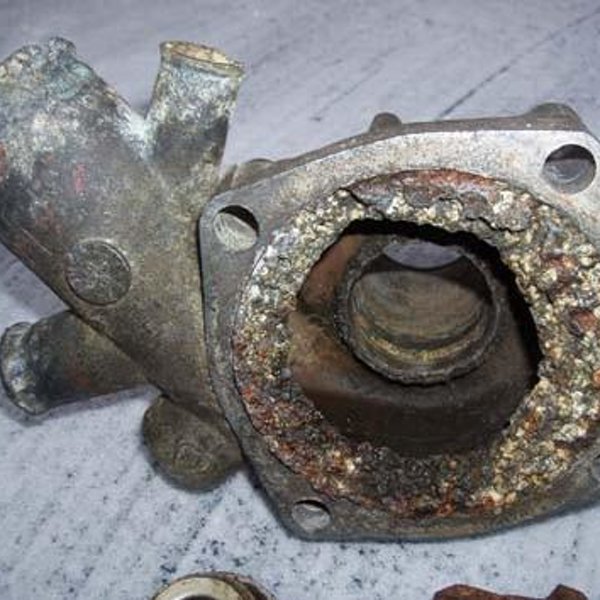

Corrosion products and various debris are most often the cause of the main valve jamming. Day after day they are deposited on the inner walls of the case and at some point begin to interfere with its free movement. This is how "sticking" happens.
As for marriage, it occurs quite often. Not a single car shop, not to mention sellers in the car market, will guarantee that the thermostat you bought will open and close at the temperature indicated in the passport, and generally work correctly. That is why ask for a receipt and do not throw away the packaging in case something goes wrong. Moreover, before installing a new part, do not be too lazy to check it.
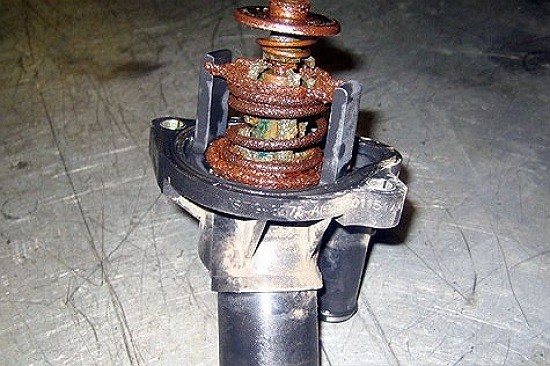

- engine oil (not working out);
- a metal container that would hold the thermostat so that it is completely covered with oil;
- gas or electric stove;
- aerosol WD-40 or equivalent;
- carburetor cleaner.
What to do if the thermostat is stuck closed on the road
On the road, a thermostat valve jammed in a small circle can cause a lot of trouble, ranging from a disrupted trip to the need for urgent repairs. However, in some cases, these troubles can be avoided. Firstly, it is important to notice an increase in the temperature of the coolant in time and prevent critical overheating of the power plant. Secondly, if you have a set of keys, and there is an auto shop nearby, the thermostat can be replaced. Thirdly, you can try to wedge the valve. And finally, you can slowly drive home.
How to check the thermostat
You can diagnose the thermostat without the involvement of specialists. The procedure for checking it is quite simple, but for this the part will need to be dismantled. We will consider the process of removing it from the engine below. And now imagine that we have already done this and the thermostat is in our hands. By the way, it can be a new, just bought device, or restored by boiling in oil.
To test the thermostat, we only need a kettle of boiling water. We place the device in the sink (sink, pan, bucket) so that the pipe connecting the part to the engine is at the top. Next, pour boiling water from the kettle into the nozzle with a small stream and observe what is happening. First, water must pass through the bypass valve and pour out of the middle branch pipe, and after heating the thermoelement and actuation of the main valve, from the lower one.
Video: checking the thermostat


Watch this video on YouTube
Replacing the thermostat
You can replace the temperature controller on a "penny" with your own hands. Of the tools and materials for this you will need:
- thin slotted or large Phillips screwdriver (depending on the type of clamps that tighten the ends of the hoses);
- wrench 13 mm;
- a container for collecting coolant;
- dry rag;
- coolant (topping up).
Removing the thermostat
The dismantling procedure is as follows:
- Set up the car on a level surface. If the engine is hot, let it cool completely.
- Open the hood, unscrew the caps on the expansion tank and on the radiator.

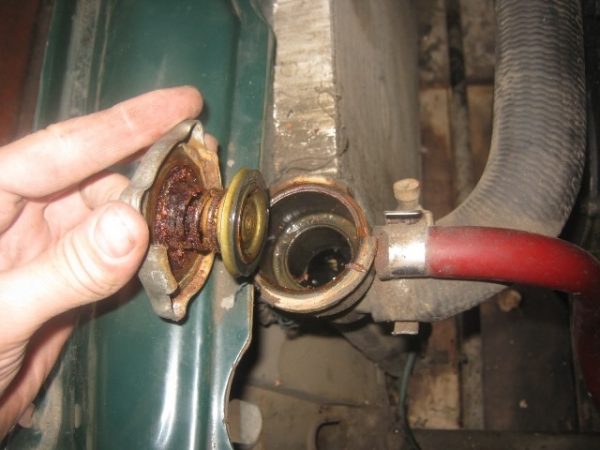 To drain the coolant faster, you need to unscrew the caps of the radiator and expansion tank
To drain the coolant faster, you need to unscrew the caps of the radiator and expansion tank - Place a container under the refrigerant drain plug.
- Unscrew the plug with a 13 mm wrench.

 To unscrew the cork, you need a 13 mm wrench
To unscrew the cork, you need a 13 mm wrench - We drain part of the liquid (1–1,5 l).

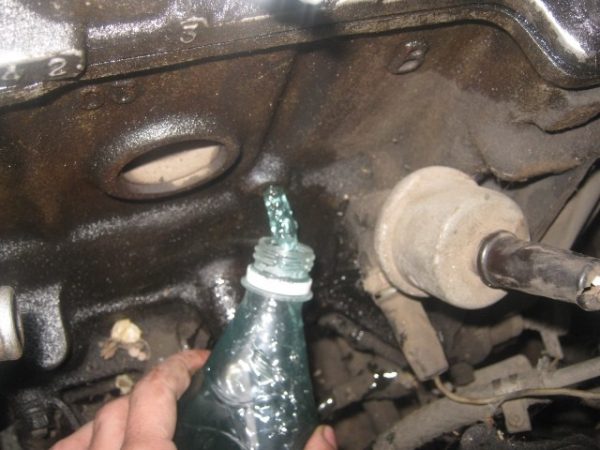 Drained coolant can be reused
Drained coolant can be reused - We tighten the cork.
- Wipe up spilled liquid with a rag.
- Using a screwdriver, loosen the tightening of the clamps and, one by one, disconnect the hoses from the thermostat nozzles.

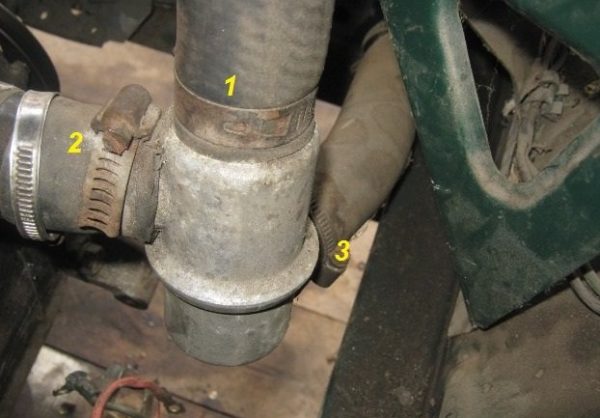 Clamps are loosened with a screwdriver
Clamps are loosened with a screwdriver - We remove the thermostat.

 When the clamps are loosened, the hoses can be easily removed from the nozzles
When the clamps are loosened, the hoses can be easily removed from the nozzles
Installing a new thermostat
To install a new part, we perform the following work:
- We put the ends of the hoses of the cooling system on the thermostat pipes.

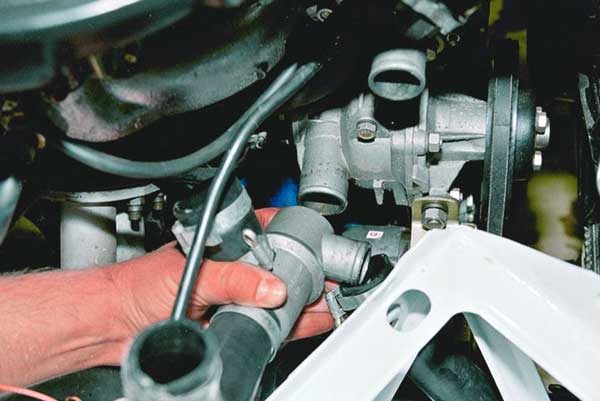 To make the fittings easier to put on, you need to moisten their inner surfaces with coolant.
To make the fittings easier to put on, you need to moisten their inner surfaces with coolant. - Tighten the clamps tightly, but not all the way.
- Pour coolant into the radiator to the level. We twist the caps of the tank and radiator.
- We start the engine, warm it up and check the operation of the device by determining the temperature of the upper hose by hand.
- If the thermostat is operating normally, turn off the engine and tighten the clamps.
Video: replacing the thermostat


Watch this video on YouTube
As you can see, there is absolutely nothing complicated either in the design of the thermostat or in the process of replacing it. Periodically check the operation of this device and monitor the temperature of the coolant, then your car engine will last a very long time.


